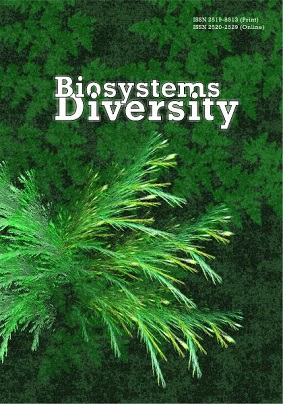Adaptive strategy of Rapana venosa (Gastropoda, Muricidae) in the invasive population of the Black Sea
Adaptive strategy of Rapana venosa (Gastropoda, Muricidae) in the invasive population of the Black Sea
Author(s): Y. V. Slynko, E. E. Slynko, V. I. RabushkoSubject(s): Geography, Regional studies, Human Ecology, Environmental interactions
Published by: Дніпропетровський національний університет імені Олеся Гончара
Keywords: rapa whelk; COI gene; invasions; morpho-ecological forms; distribution;
Summary/Abstract: We conducted molecular-genetic and morphological studies on the veined rapa whelk Rapana venosa (Valenciennes, 1846) in the Crimean waters of the Black Sea in order to determine possible reasons of the invasive success of this mollusk. Molecular-genetic tests were performed using COI gene; the surveyed samples reliably identified to R. venosa species. We compared the data on initial (from the Far-Eastern seas) and some invasive populations. In the natural conditions of the Yellow, East China Seas, and the Sea of Japan, the genetic diversity of rapa whelk is high (Hd = 0.933, π = 0.002). In all the invasive populations of rapa whelk (Black Sea, European and North American), an extremely low level of haplotypic and nucleotide diversity was determined (Hd = 0.0, π = 0.0). Despite low values of genetic diversity, the invasive populations of rapa whelk are characterized by ecological success. We noted stable growth of populations, tolerance to diseases and parasites, effective reproduction, high fertility. This contradicts the main provisions of the population genetics theory of formation of edge of range populations, because usually only a small number of specimens of rapa whelk were introduced. The explanations of the unique condition of the invasive populations of rapa whelk, both from an ecological perspective (high resistance to fluctuations of hydrologicalfactors and chemical pollution, absence of enemies, high fertility) and genetic perspective (high selective value of separate haplotypes settled in the new water areas) have not been confirmed. We determined that a very important factor for the naturalization of the rapa whelk at low genetic diversity is the intra-species morpho-ecological divergence. In the Crimean water area of the Black Sea, R. venosa was found to have two morpho-ecological forms associated with the peculiarities of the development of the proportions of the shell. Study of successful invasive species would allow timely and adequate reaction to new cases of introduction.
Journal: Biosystems Diversity
- Issue Year: 28/2020
- Issue No: 1
- Page Range: 48-52
- Page Count: 5
- Language: English

